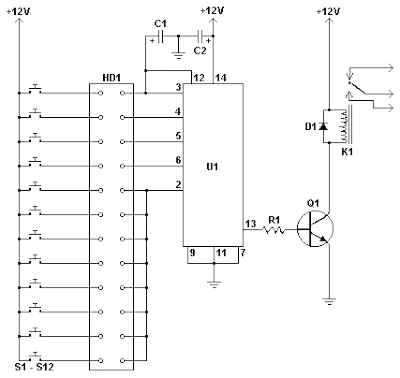This simple circuit is the electronic version of the combination lock. Using the special purpose LS7220 digital lock IC, the circuit allows a 4 digit combination of your choice to activate a relay for a set period of time. This relay can then be used to trigger a lock solenoid, enable a starter button, open a motorized door, or many other tasks that require a momentary signal.

Parts
| Part | Total Qty. | Description | Substitutions | | C1 | 1 | 1uF 25V Electrolytic Capacitor |
| | C2 | 1 | 220uF 25V Electrolytic Capacitor |
| | R1 | 1 | 2.2K 1/4W Resistor |
| | Q1 | 1 | 2N3904 NPN Transistor | 2N2222 | | D1 | 1 | 1N4148 Rectifier Diode | 1N4001-1N4007 | | K1 | 1 | 12V SPDT Relay | Any appropriate relay with 12V coil | | U1 | 1 | LS7220 Digital Lock IC |
| | S1-S12 | 12 | SPST Momentary Pushbutton | Keypad (see notes) | | HD1 | 1 | 12 Position Header |
| |
|
- To set the combination, wire the appropriate switches to U1 pins 3, 4, 5 and 6 using the header. For example if S1 was connected to pin 3, S2 to pin 4, S3 to pin 5 and S4 to pin 6, the combination would be 1,2,3,4. Now wire all other unused switches across the header to pin 2 of U1. In this way you can create any 4 digit combination you want. Pin 2 is the reset pin, so connecting all unused keys to it assures that the entire combination must be reentered if an incorrect key is pressed.
- When the appropriate combination is entered, the relay is activated for a period of time determined by C1. The 1uF capacitor specified in the parts list will result in an on-time of roughly 5 seconds. Increase the value of C1 to increase this time.
- An easy way to make a keypad is to buy 12 PC board mount pushbuttons and then etch a PC board so that the buttons are in 4 rows of 3, similar to a telephone keypad. Place this in a case and then use a label maker or transfer letters to add your numbers to the tops of the pushbuttons. You can also use a pre made keypad but keep in mind that you need a pad which provides an output for each key. Most pads available have the keys connected to provide a row and column signal when they are pressed.
Source: www.aaroncake.net

0 comments:
Post a Comment
Note: Only a member of this blog may post a comment.